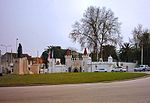Ponte de Santa Clara
Buildings and structures in Coimbra

The Ponte de Santa Clara (Portuguese for Santa Clara Bridge) is a t-section and haunched girder bridge completed and opened on 30 October 1954, crossing the Mondego River leading to the town square of Coimbra. It was inaugurated on the same date it opened by prime minister António de Oliveira Salazar for a total cost of 15,000 contos (€ 75,000).
Excerpt from the Wikipedia article Ponte de Santa Clara (License: CC BY-SA 3.0, Authors, Images).Ponte de Santa Clara
Ponte de Santa Clara, Coimbra Alta (Coimbra (Sé Nova, Santa Cruz, Almedina e São Bartolomeu))
Geographical coordinates (GPS) Address Nearby Places Show on map
Geographical coordinates (GPS)
| Latitude | Longitude |
|---|---|
| N 40.206111111111 ° | E -8.4305555555556 ° |
Address
Ponte de Santa Clara
Ponte de Santa Clara
3000-382 Coimbra, Alta (Coimbra (Sé Nova, Santa Cruz, Almedina e São Bartolomeu))
Portugal
Open on Google Maps










